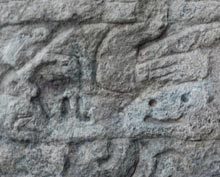Scientists who have found evidence of an ancient forest buried under six feet of mud in Nantucket Sound say the discovery could help answer questions about early people in North America.
Comment: Even though there is ample evidence that people came to North America long before 12,000 years ago, evidence that is conveniently ignored, dismissed, locked up in the back room, or just destroyed, the debate goes on. Rather than wondering whether or not there might have been a highly developed civilisation prior to 12,000 years ago, one destroyed by, oh, a few large pieces of space debris raining down, they talk about whether people arrived via Asia or the east coast.
The earliest known portrait of a woman carved by the Maya suggests women may have held positions of authority in their society, a Canadian archeologist says.
The carving from the Guatemalan site of Naachtun likely dates to the end of the fourth century, when Mayan dynasties were being established.

|
| ©University of Calgary
|
| A close-up of the carving.
|
Comment: Earth goddess or Mayan Nefertiti?
Robin McKie, science editor
The GuardianMon, 05 Dec 2005 12:00 UTC
The new science of geomythology is being harnessed by researchers who believe folklore can save lives
On the banks of Siletz Bay in Lincoln City, Oregon, officials dedicated a memorial last week to one of America's worst calamities: a huge earthquake and tsunami that killed thousands of Native Americans 300 years ago.
But the memorial's main job is not to commemorate the disaster, which has only just come to light, but to warn local people that similar devastation could strike at any time.
Comment: Comment: We knew that Laura's work on mythology and natural disasters was scientific. Now they even have a name fer it!
University of Hawaii astronomer Fabrizio Bernardi came here from Italy to look for potentially dangerous asteroids.
"But, of course, we see other objects -- stars and comets. This time, the first time, I saw a new comet," the postdoctoral researcher said.
Bernardi was looking at images taken with the Canada-France-Hawaii Telescope on Mauna Kea when he noticed an object that was "a bit fuzzy," with a tail estimated at more than 13,000 miles long.
Los Angeles--On the day after Christmas, a long-standard survey of people's television watching habits will take a first step into the digital present--and future.
For decades, the Nielsen Media Research audience measurement service has told networks and advertisers roughly how many people are watching, for example, ABC at 9 p.m. on a Wednesday. But as a growing number of people use TiVo or another service to record prime time shows for viewing later in the week or for watching on a laptop during a flight, the Nielsen ratings have gotten increasingly fuzzy.
In late December, Nielsen is finally taking one of several steps aimed at adapting to this new audience. Ratings will be broken out by how shows are watched--live, later in the day or within a seven-day period. Over time, Nielsen will also move to measure viewing that takes place via iPods, cell phones, laptops and other digital devices that are gaining TV privileges. The company also will track audiences for on-demand fare."I don't even try to figure out what's happening today. It's more important to try to figure out where we're going to be in 10 months, and then try to figure out how to get there."--Steve Schwaid, senior VP, NBC Universal
Marks that were hailed as the earliest traces of humans in the Americas may not be what they seem. A dating study puts the age of the volcanic ash in which the indentations were found at 1.3 million years, which casts fatal doubt on the theory that they are footprints.
Comment:
Tim White, a palaeoanthropologist at the University of California, Berkeley, says Gonzalez's previous evidence "is not sufficient to convince me they are footprints"...
Galileo insisted that the Earth revolved around the Sun and got into hot water for it, but today, he is revered as one of the most important scientists in history. Strange thing, that.
Laura Knight-Jadczyk
Sott.netFri, 02 Dec 2005 12:00 UTC

© SOTT.net
.
The most widely used method for determining the age of fossils is to date them by the known age of the rock strata in which they are found. At the same time, the most widely used method for determining the age of the rock strata is to date them by the known age of the fossils they contain. In this circular dating method, all ages are based on uniformitarian assumptions about the date and order in which fossilized plants and animals are believed to have evolved.
Most people are surprised to learn that there is, in fact, no way to directly determine the age of any fossil or rock. The so called absolute methods of dating (radiometric methods) actually only measure the present ratios of radioactive isotopes and their decay products in suitable specimens - not their age. These measured ratios are then extrapolated to an age determination.
The problem with all radiometric clocks is that their accuracy critically depends on several starting assumptions, which are largely unknowable. To date a specimen by radiometric means, one must first know the starting amount of the parent isotope at the beginning of the specimen's existence. Second, one must be certain that there were no daughter isotopes in the beginning. Third, one must be certain that neither parent nor daughter isotopes have ever been added or removed from the specimen. Fourth, one must be certain that the decay rate of parent isotope to daughter isotope has always been the same. That one or more of these assumptions are often invalid is obvious from the published radiometric dates (to say nothing of rejected dates) found in the literature.
Comment: So, when scientists say "footprints are too old to be human," that is a subjective opinion.
Scientists have cast doubt on the age of footprints discovered in Mexico, which suggested humans had arrived in the Americas 30,000 years earlier than previously thought.
The fossilised footprints discovered two years ago in volcanic ash near Puebla, Mexico were thought to be 40,000 years old, but researchers in the United States and Mexico who visited the site and collected samples came to a different conclusion.
Comment: From Encyclopedia Brittanica: method of determining the time of origin of rocks by measuring the ratio of radioactive argon to radioactive potassium in the rock. This dating method is based upon the decay of radioactive potassium-40 to radioactive argon-40 in minerals and rocks; potassium-40 also decays to calcium-40. Thus, the ratio of argon-40 and potassium-40 and radiogenic calcium-40 to potassium-40 in a mineral or rock is a measure of the age of the sample. The calcium-potassium age method is seldom used, however, because of the great abundance of nonradiogenic calcium in minerals or rocks, which masks the presence of radiogenic calcium. On the other hand, the abundance of argon in the Earth is relatively small because of its escape to the atmosphere during processes associated with volcanism.
The potassium-argon dating method has been used to measure a wide variety of ages. The potassium-argon age of some meteorites is as old as 4,500,000,000 years, and volcanic rocks as young as 20,000 years old have been measured by this method.
Joanna Glasner
WiredFri, 02 Dec 2005 12:00 UTC
When seeking the source of a mysterious malaise, few people would think to blame ions trapped in their mattress coils or cyclotronic resonance from the electrical system.
But if they did, they'd find products already on the market to allay their symptoms.
Comment: Wonder why it's a "tipoff when you see lots of testimonials?" Marketing that relies on "subjective claims?" Just because scientists don't know how things work doesn't mean they don't work. We aren't saying they DO work, but no reason to not try them if you have a problem and science or medicine don't have a solution for you.
A scientist poring over 330-million-year-old tracks in a layer of sandstone in Scotland believes they were made by an extraordinary water scorpion that was as big as a man.
The huge six-legged creature was about 1.6 metres (64 inches) long and a metre (40 inches) wide, according to the study, published on Thursday in Nature, the weekly British science journal.

Comment: Even though there is ample evidence that people came to North America long before 12,000 years ago, evidence that is conveniently ignored, dismissed, locked up in the back room, or just destroyed, the debate goes on. Rather than wondering whether or not there might have been a highly developed civilisation prior to 12,000 years ago, one destroyed by, oh, a few large pieces of space debris raining down, they talk about whether people arrived via Asia or the east coast.